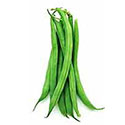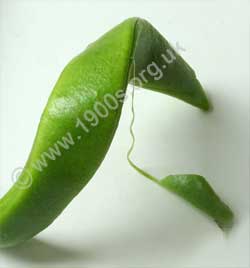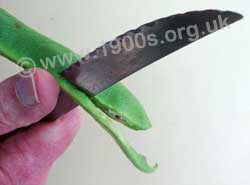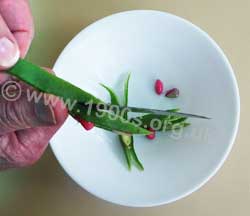Stringing and slicing runner beans using a knife

Runner beans, also known as pole beans, are well-worth growing. They are delicious vegetables as side dishes on any cooked meal, are nutritious and exceptionally easy to grow in the smallest of spaces. They have one drawback though: they are time-consuming to prepare because every bean needs the outer string removed and then to be cut or sliced into smaller pieces for cooking. This page describes how it was done in the past which was heavily labour-intensive, although regarded as worth the trouble. The companion page describes today’s far easier preparation.
____
By the webmaster, based on watching and talking to older people
The string of a runner bean

The string on a runner bean left too long before picking
Because families tended to be so large, quite a number of beans were required for each meal and I suspect, therefore, that the beans were allowed to grow much larger than I recommend on the gadget page.
Consequently it was necessary to remove what was called the 'string' at the sides of beans which developed as they aged.
As a child, I clearly remember trying to eat 'stringy' beans which had not been sufficiently carefully prepared. These strings would not chew up into nothing and the only solution when finding one in the mouth was either to chew it into a ball and swallow it like a pill or, as unobtrusively as possible, remove it to the side of the plate in the hope that whoever prepared the meal wouldn't notice.
Removing the strings of runner beans
Every bean had to have its sides sliced off and discarded to remove the strings. This was not only labour-intensive, it required some judgement as to how deeply to cut. Too deeply meant that some of the bean was wasted, but not deeply enough meant that the dreaded string remained.

Cutting the sides off a runner bean to remove its strings - but see today's easier way.
I once saw my father stringing the day's runner beans for my mother. He said that in his childhood in the early 1900s it would have been one of the jobs of the older children, which is why he knew how to do it. He stressed 'older' children because they had to be trusted with a knife that was really sharp.
Slicing the runner beans
Once the stringing was complete, the beans had to be sliced for cooking. This too had to be done by hand and with a sharp knife. The cuts were always made at an angle crossways so that any remaining string would, at least, be cut into short pieces.

Slicing a runner bean cross ways with a knife - but see today's easier way.
It was considered a skill to slice the beans thinly for the table, although when I tried, in order to take the photos for this page, I found it almost impossible, probably because today's stainless steel knives are not as sharp as the old non-stainless ones which the knife and scissor sharpeners used to sharpen regularly when touring the streets .

Beans sliced with a knife ready for cooking
The resulting beans look nowhere near as attractive as the sliced beans produced with the modern gadget described on the companion page. Neither, being thicker, would they have been as tender to eat.
If you can add anything to this page or provide a photo, I would be pleased if you would contact me.
Text and images are copyright
sources: early 20th century material
sources: ww2 home front and other material
contact
the webmaster/author/researcher/editor
privacy policy



